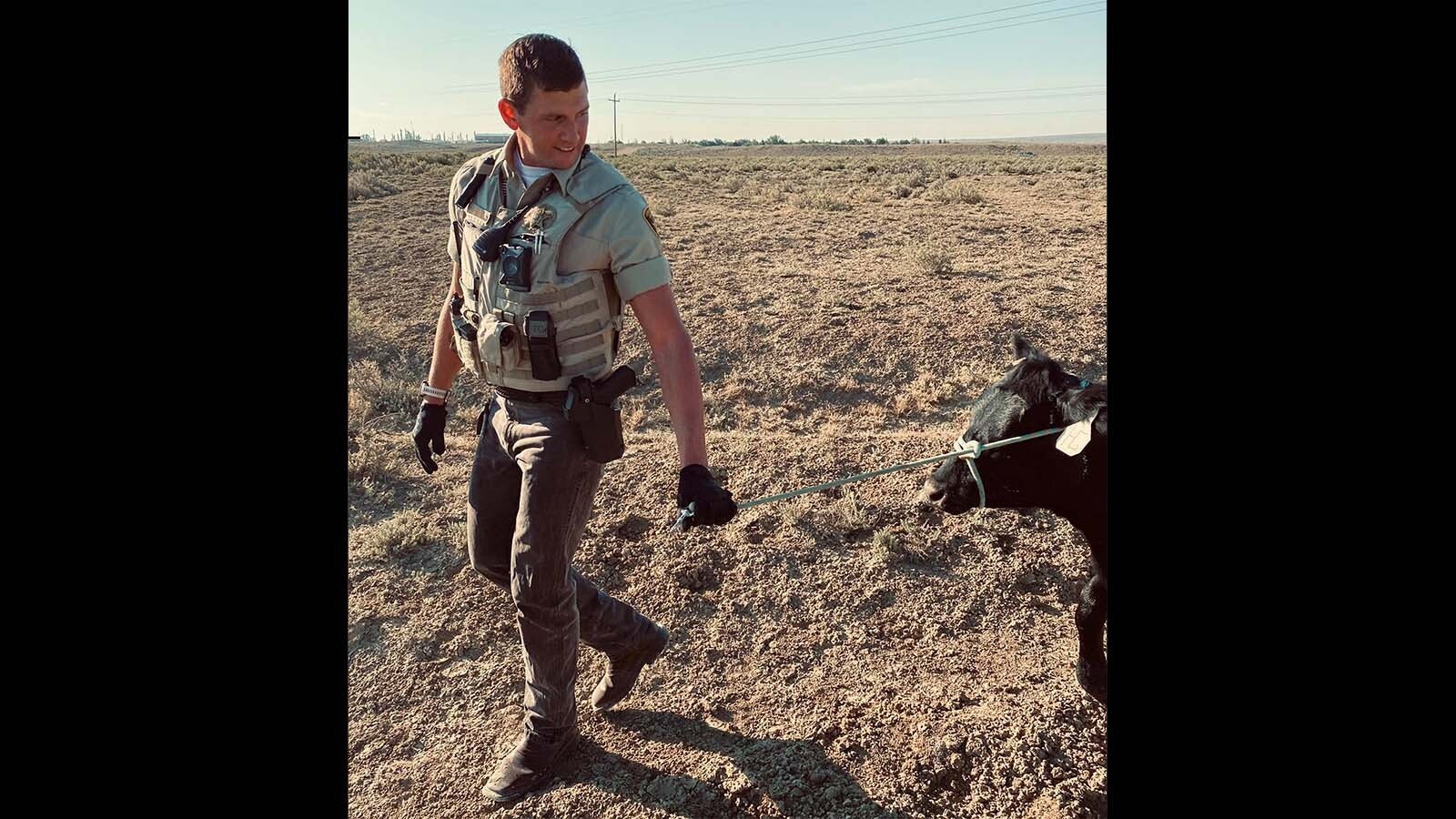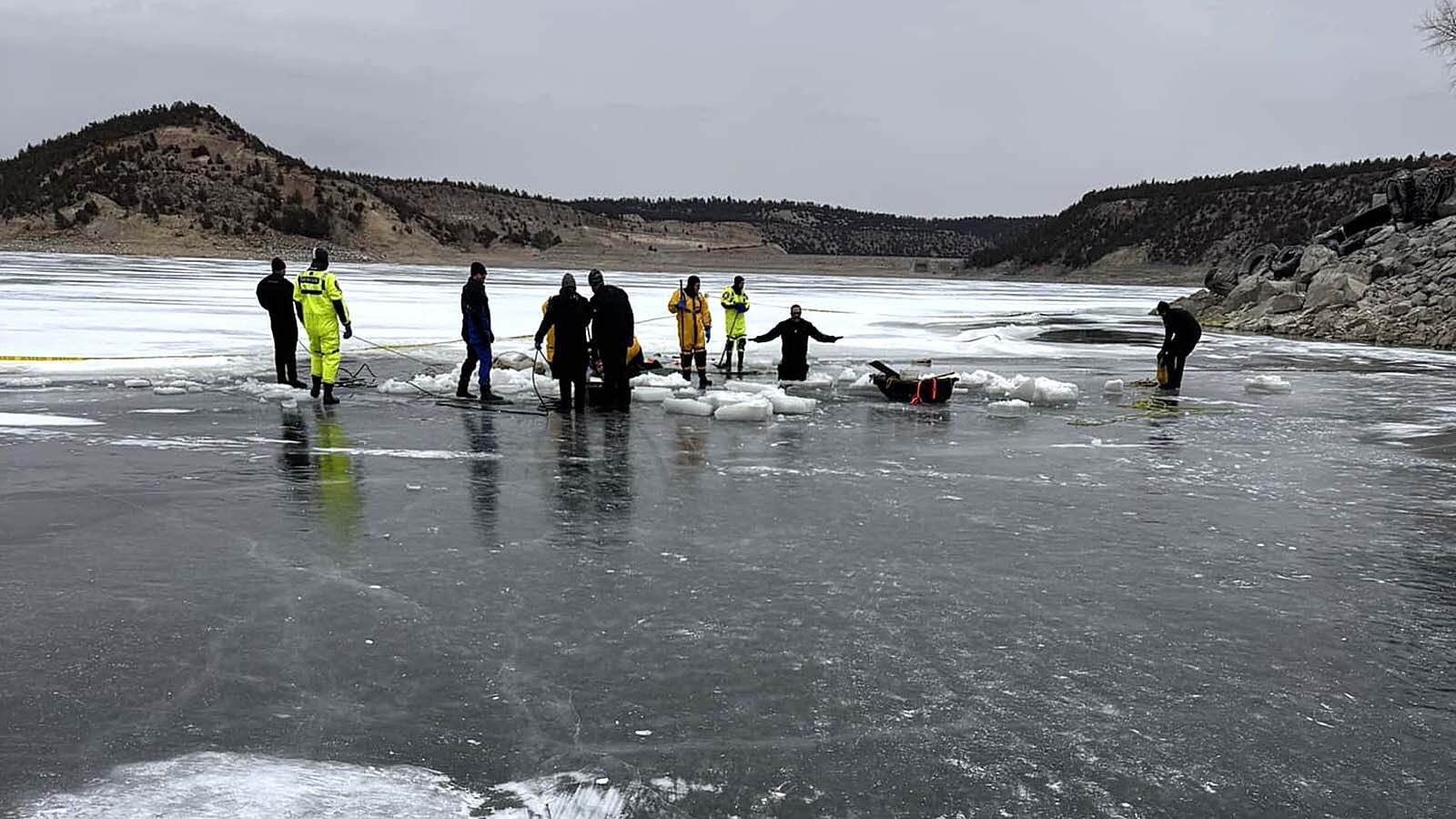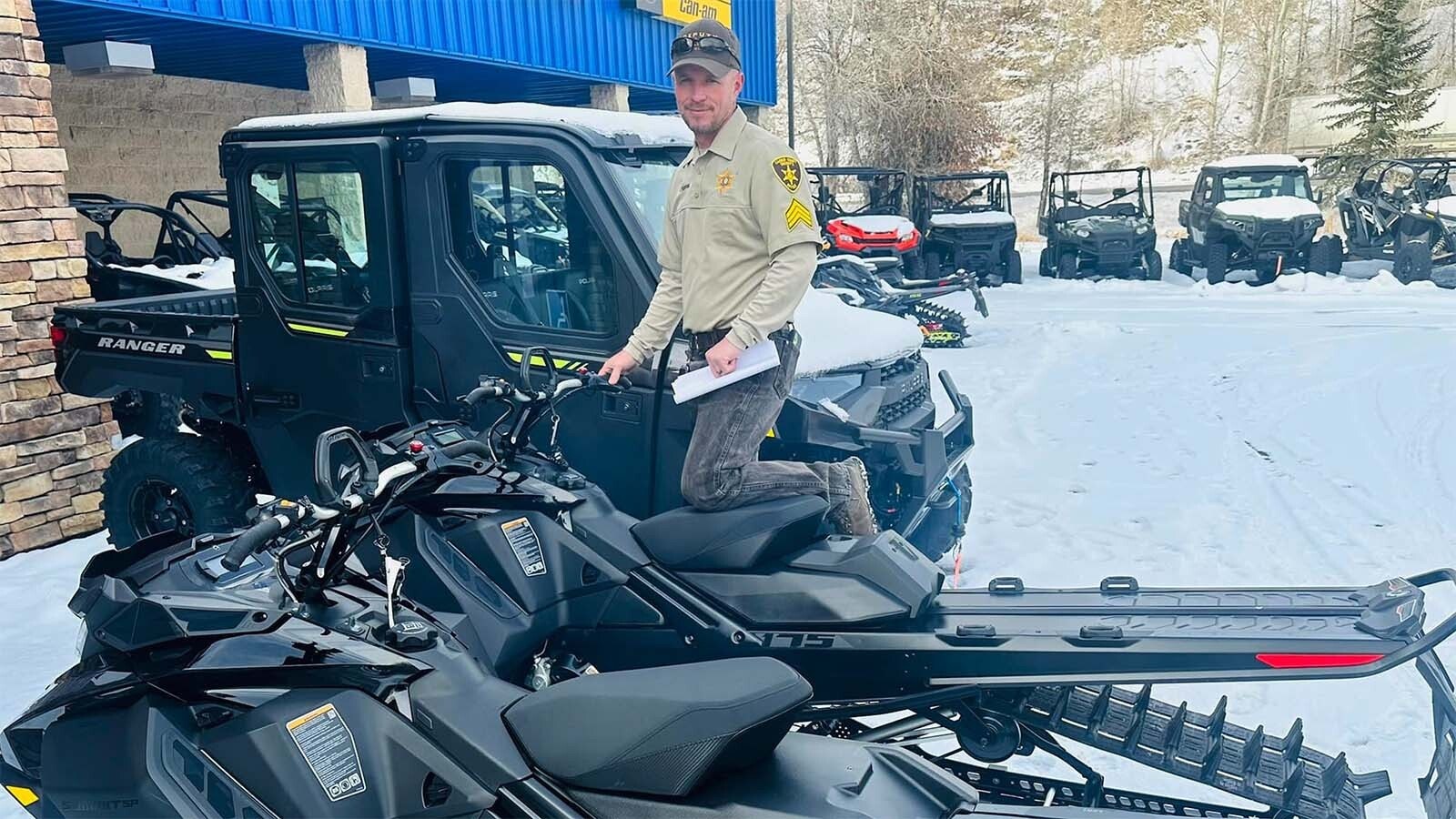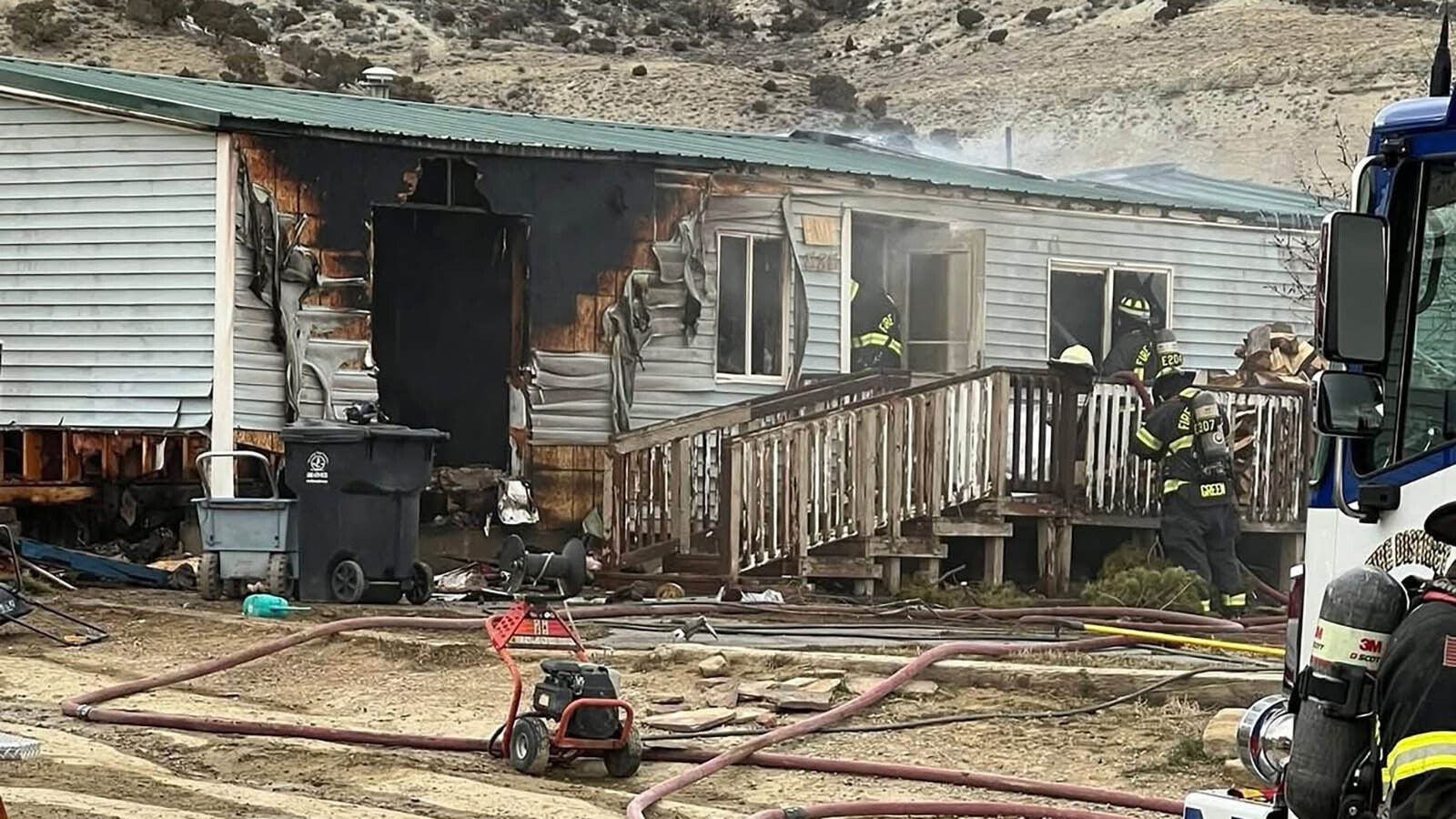Hulett Police Chief Bill Motley drove down Main Street on a recent June day as he completed his morning rounds.
This consists of checking for signs of break-ins, vandalism of local businesses and anything else that doesn’t look right in the small town of around 400 people tucked in the far northeast corner of Wyoming less than 10 miles from Devils Tower.
Someone waved from the sidewalk, and Motley slowed down to see if everything was OK. It was. That person was just saying “hello.”
It was a typical morning, and after nine years on the job, Motley has racked up many of them.
Like other police chiefs in small Wyoming towns, he heads up the one-man force in charge of patrolling the town.
It’s just him with the exception of the annual Sturgis Motorcycle Rally, when he’s budgeted to borrow four part-timers from neighboring agencies for the week.
Otherwise, it’s an around-the-clock job for Motley, who may get called out at 10 p.m. for a bar fight or an early morning call for strange noises.
In between, he patrols the streets, visits students at the school, checks on a handful of seniors and sometimes answers Life Alert calls.
Being police chief also means that residents have his cellphone number and know where he lives, so sometimes people bypass dispatch altogether to call him directly or just show up at his door.
When he needs to be out of town for National Guard duty or vacation, he calls in the Crook County sheriff for backup.
Modern Mayberry
Most days, Hulett’s a pretty quiet community, Motley said, and the town doesn’t see a lot of crime.
Like other rural Wyoming communities, Hulett has its fair share of drugs — mostly marijuana — along with assaults and battery and lots of traffic violations.
“We have the same crimes as everybody else,” he said. “It’s just a normal life in a small town.”
It’s safe to say that everyone knows everyone. Transients don’t go unnoticed for long, including a traveler who found himself stranded by the side of the road just out of town.
After the eighth call from concerned citizens, Motley loaded the guy up and drove him 94 miles to Rapid City, South Dakota, to drop him off at a truck stop.
Sometimes, situations call for creative solutions.
“It was the best way to handle that situation for his safety and my peace of mind,” Motley said.
A Kentucky native, Motley began his law enforcement career at a detention center in Indiana.
After 30 years on the job, including stints in Thermopolis and as a sheriff’s office deputy in Platte County, Motley has learned pretty much everything he knows on the job — and sometimes the hard way.
Like most law enforcement in Wyoming, he’s not there for the paycheck and has learned to stretch a thin budget a long way while putting in lots of hours.
But he also loves the job.
“Being a small-town cop has its benefits, and its downside, but I think the benefits far outweigh the downside,” he said.

Doing A Lot With A Little
Hulett is emblematic of what rural policing looks like in the least-populated state of just over half a million residents with the 10th largest landmass.
The state’s population continues to grow slightly at 587,618 people as of July 2024, according to estimates from the U.S. Census Bureau and Wenlin Liu, chief economist at the Wyoming Economic Analysis Division.
Hulett is in Crook County, which was the fastest growing county in Wyoming in 2024 with a 2.4% annual growth rate, according to the same data. The other two fastest growing counties were Albany and Sheridan at 1.7% and 1.2% growth, respectively.
The population growth doesn’t necessarily keep up with law enforcement budgets, say Wyoming sheriffs, who are charged with policing large counties with limited budgets.
Small budgets, vast distances and a lack of manpower in general are just a few issues common to rural law enforcement across Wyoming.
Wyoming also is not unique when it comes to challenges in rural policing.
Insufficient funding was the overarching concern for rural law enforcement in at least five other states, according to the 2020 survey “Conversations With Rural Law Enforcement Leaders Vol. 1” by the National Police Foundation with funding from the U.S. Department of Justice.
The information was compiled from interviews with rural law enforcement agencies in Montana, South Dakota, Utah, Oklahoma and Iowa.
Much like in Wyoming, these agencies bemoaned the ways in which a lack of funding impacts their ability to hire and retain peace officers to cover relatively vast territories while also affording proper equipment and alleviating overcrowded jails.
The study also found that insufficient funding had a ripple effect when communities lacked adequate substance abuse and mental health services, which exacerbates substance abuse and a myriad of related crimes, further straining resources.
Staffing shortages were also noted as a key concern as population in many areas continues to grow amidst stagnant budgets and increased responsibilities.
Large Land Mass
Carbon County might be the perfect example of the challenges facing rural law enforcement as the county with the lowest population density in the state, said Sheriff Alex Bakken.
At just under 8,000 square miles and a population of around 14,500, the county consists of 10 municipalities — Baggs, Dixon, Encampment, Elk Mountain, Hanna, Medicine Bow, Rawlins, Riverside, Saratoga and Sinclair.
Of those, only four — Encampment, Rawlins, Saratoga and Sinclair — have police departments while Hanna has a marshal and two part-timers.
Bakken’s office also has agreements with the smaller communities that can’t afford to hire a police chief to provide law enforcement services.
At the risk of sounding cliché, Bakken said that by far the biggest issue facing his department is a lack of money, which adds to the difficulty of policing such a large county.
“We are ultra rural, if you want to say, and we don’t generate enough revenue to sustain the services to cover such a large land mass,” Bakken said.
Because property taxes comprise a large portion of funding, Bakken predicts his budget will get even tighter following the passage of a 25% property tax cut this year.
“We just don’t generate that much funding as a county,” Bakken said. “And with the property tax reduction act that was passed in this year’s legislative session, we’re looking at a pretty bleak future.”
There’s hope on the horizon that some of the proposed wind energy projects for the county will give the local economy a boost, he added, but that might be years down the road.
In the meantime, he writes a lot of grants for equipment and other programs and relies on the generosity of donations to his office from the community, which have been substantial over the past two years, he said.
On top of regular patrol duties, the sheriff’s office is also in charge of search and rescues in a state that draws outdoor recreationists from all over.
Carbon County relies on volunteers and has recently restructured its two search and rescue teams into tax-exempt nonprofits to increase donations to fund operations.
On average, Bakken estimates the county conducts about 25 operations a year, though so far this year, that number is on pace with 20 missions, including one this week in which Bakken and another rescuer saved three teens lost on Medicine Bow Peak.
Keeping Morale High
Since taking over in 2022, Bakken has been able to make several positive improvements, including upgrading the sheriff’s office’s weapons and technology in patrol cars, which helps keeping deputies’ morale high.
“We’ve made a lot of positive changes, and I think that helps,” he said. “We believe in our vision and want to make a positive difference in the county.”
The sheriff’s office employs 17 sworn staff for patrols and an additional 21 to staff the county’s detention center. Bakken estimates that each deputy costs the county an average of $100,000 a year with salary, benefits and insurance.
“We have a really strong office,” he said. “I’m really proud of everyone and what they bring to the table.”
Now he’s working on reallocating money to increase salaries to stay competitive with other departments in and out of the county, which has required him to eliminate two positions.
“Cutting these positions is not an easy choice, and in a perfect world, we wouldn’t have to, but one of the issues we’re running into is recruitment,” he said.

Low Pay An Issue
Nobody knows this better than Platte County Sheriff David Russell who is down seven positions and actively recruiting to hire a patrol deputy and detention officers.
“We’re down like everybody else,” Russell told Cowboy State Daily. “We can’t offer the salaries that the bigger or wealthier counties can.”
A current job opening for a deputy sheriff offers $19.50 to $23.50 an hour while the pay rate for a full-time dispatcher position has a salary range of $3,200 to $3,500 a month, according to job postings on the county’s website.
Low wages compared to other counties, on top of limited amenities and social opportunities for single people and families, are two of the challenges in recruiting new deputies, Russell said.
To compensate, the county lowered the hiring age to 18.
Currently, the sheriff’s office employs 34 sworn deputies and detention officers as well as eight civilian staff members to cover just over 2,000 square miles that encompasses five cities with a population of around 8,600 people.
Like Bakken, Russell writes a lot of grants with the goal of bringing in about 50% of his operating budget, including money to put school resource officers in both school districts.
At age 31, Russell is the youngest sheriff in the state and the second youngest in state history. He took office in 2023. Before that, he was a Platte County sheriff’s deputy and a seasonal Wyoming park ranger.
He’s also one of the more educated sheriffs with a master’s in law enforcement and public safety leadership and is currently working toward a doctorate in criminal justice.
Russell said Platte County is a lot like other jurisdictions throughout rural Wyoming. Most of the crimes deputies respond to are either drug or alcohol related, including domestic assaults, theft and property destruction.
“On the drug side, we’re seeing a lot of meth and fentanyl,” he said.
They also get their fair share of high-speed chases on Interstate 25, which runs through the county. In spring 2022, they were logging about one a week, which has since tapered off to about six last year.
Like other Wyoming agencies, Russell said his biggest challenge is trying to do more with less every year.
The job hasn’t changed, but the cut in manpower makes it more difficult to cover the rural county where it might take 45 minutes to get from one end to the other.
“We’re still doing the same job, but with less staff,” he said.
Response Times
The shortage of manpower exacerbates the slow response times given the vast spaces that sheriffs cover.
Slow response times in Carbon County are one of their biggest problems that Sheriff Bakken would like to see improve.
On a good shift, he said, there will be two to three patrol deputies to cover the entire area.
Given the vast distances between towns, it might take a deputy two hours to get from one corner to the other, and that’s in good weather.
As a patrol deputy, he’s been in that situation. In one instance, his partner on duty had been on domestic violence call in the Encampment area in southcentral Carbon County, when they were alerted to another domestic violence situation in progress in Medicine Bow in the far northeast corner.
When the call came in, Bakken had been in Baggs, in the southwest corner, prompting him to drive about an hour to respond.
A lot can happen in an hour, Bakken noted, but luckily by the time he arrived the dispute had ended. Though the female had visible physical injuries, she declined to press charges.
“Luckily, it didn’t end up in a fatality because we took so long to get there,” Bakken said.
As sheriff, he’s since helped alleviate those types of response times by procuring funds to pay deputies to be on call. But still, he’d like to have more manpower in general.
“Unfortunately, that’s just the reality of trying to police such a large area with such a small force,” he said.
Riding Solo
Deputies also have to respond to calls alone, which flies in the face of standardized law enforcement training that calls for a minimum two-officer response, particularly when it comes to domestic violence incidents.
“For the most part, there’s a lot of unknowns with a domestic with a lot of potential to deteriorate,” Bakken said.
A Campbell County sheriff deputy learned that the hard way when he was shot at last August.
He was responding to a domestic call in Wright, a small town of around 1,653 about 40 miles south of Gillette, when he was ambushed by gunshots.
He’d barely opened his door when the shots rained into his windshield. He was able to duck to cover behind the door and was able to shoot the perpetrator, but that’s the reality of small-town policing.
Because Wyoming deputies typically respond on their own, they receive a lot of training on single-officer responses and safety.
They’re also trained to be good communicators.
“It’s really incumbent upon you to be able to communicate, because your backup is a long ways away,” Bakken said.

Bucking National Trend
Surprisingly, Wyoming has a low fatality rate for officer-involved shootings.
According to FBI data, there were no law enforcement officers killed in Wyoming between 2014 - 2023, which is the most recent year in publicly available records.
The most recent death was Sheridan Police Sgt. Nevada Krinkee who was killed while serving a trespass warrant on Feb. 13, 2024.
According to the Officer Down Memorial Page, which tracks police deaths nationwide, 62 Wyoming officers have died in some capacity while on duty dating back to the state’s founding.
Lower Crimes
Relatively speaking, Wyoming also has a low crime rate nationally. In 2022, Wyoming had the fifth lowest crime rate in the nation at 201.9 crimes per 100,000 residents. Maine had the lowest crime rate, followed by New Hampshire, Connecticut and Rhode Island, according to USA Facts, a nonpartisan nonprofit that tracks population data.
However, violent crime in Wyoming has continued to slowly rise over the past four years, according to data from the Wyoming Division of Criminal Investigation.
In 2021, there were 1,199 violent crimes compared to 1,290 in 2024. Of those violent crimes in 2024, aggravated assaults accounted for the lion share at 715, followed by sexual assaults at 520 with a significant decline in robberies compared to 2023 at 42 and 13 homicides.
There’s no breakdown for where these crimes occurred, but each county has its own unique challenges and various types of crime.
Crowding Leads To More Problems
In Big Horn County, for example, the sheriff’s office tackles a wide variety of incidents from cattle rustling to disputes between neighbors, missing people and other crimes.
This past February, the county experienced one of the worst incidents to date when a Byron mother shot her four children before taking her own life.
Big Horn Sheriff Ken Blackburn said he and his staff are still recovering from the emotional and psychological after-shocks of responding to such a traumatic event that rocked the small community and state.
As one of the longest-serving sheriffs, Blackburn has worked in law enforcement 37 years with 40 years as a first responder.
Much like Carbon County, Blackburn is charged with overseeing an enormous county of about 3,159 square miles with 11 municipalities and a population of just over 12,000 residents, according to a July 1, 2024, estimate by the U.S. Census Bureau.
Of these, only a handful have their own police departments, and the Big Horn County Sheriff’s Office is charged with covering the county with a small staff.
Along with budget shortfalls, Blackburn said one of the challenges his county faces is an influx of people that are further stretching their already limited resources.
Last year, Big Horn was the fourth fastest growing county in a state that values its privacy, personal freedoms and open spaces.
As the rural community gets more crowded, Blackburn said, neighbors seem to be bickering more and calling his office to handle those disputes.
He believes that the divisive nature of politics right now in general is manifesting into disputes as increasingly people seem less inclined to respect one another’s differences.

Difficult Terrain
Along with budgetary constraints, one of the biggest challenges his office faces is navigating vast and mountainous terrain.
Like Bakken, Blackburn is charged with covering a lot of space with very limited manpower, on top of providing security to the schools and in the courthouses.
And much like Carbon County, it might take a deputy two hours to get from one end of the county to another through rugged terrain. And that’s in good weather.
“Wyoming is known for its weather conditions, and it can be very difficult to access some of the areas to get to locations in a timely manner,” he said.
Along with the mountains, Big Horn County also has a sizeable wildlife population, Blackburn said, including threatened and endangered animals that are expanding their ranges and leading to increased conflict among humans and domestic animals.
His office also still deals with livestock crimes like cattle rustling, which is something they still see, especially in light current record high beef prices.
“That’s a pretty tempting thing for a thief,” Blackburn said.
Drug Stockpiles
Perhaps more concerning to Blackburn, however, is the state’s vast terrain that makes it easy for criminal organizations to move and store drugs in rural communities.
“It’s a known fact that Wyoming and Montana are some of the largest drug storehouses for the cartels in the United States,” he said.
And as the border security continues to tighten and the U.S. Immigration and Customs Enforcement (ICE) ramps up arrests – both things that Blackburn supports – but that he also believes will create a more dangerous environment as supply dwindles and demand increases.
It’s an issue of simple economics, he said, and might lead to those with substance abuse issues getting more desperate for those limited drugs.
“The reality is, on any given day you have to plan for your worst emergency, and these are the things that law enforcement folks are planning for right now,” he said.
Backup A Long Way Off
And just like sheriff’s offices around the state, Big Horn County Sheriff deputies typically respond to calls alone, which means they may be there by themselves for long periods of time.
It’s also different when law enforcement know the people they may be arresting.
In his mind, that’s the biggest difference between rural and urban policing where in rural law enforcement you typically have had some experience with the person – for better or worse – on about 85% of the calls.
He referenced a shooting between one of his former deputies, who was then the chief of police chief in a neighboring jurisdiction. The officer was good friends with a guy who raised a rifle at him with the goal of suicide by cop. The officer had no choice but to shoot.
“We handle these things, but these are also members of our communities and our friends that we have an emotional involvement with,” he said. “It's not like the big cities where you're just a statistic or a number. These are real people to us as well.”
Another difference in rural policing, Blackburn said, is that small staffs force deputies to do a little bit of everything – most of which is learned on the job – instead of developing specialties.
“It’s called on-the-job training,” he said. “It’s not like any other job because so much of what we do requires so much adaptability.”
Adapting To The Times
This requires them to do continual trainings to maintain an operational readiness to stay safe on the job.
And like all Wyoming agencies, the sheriffs rely on assistance from other local, state and federal agencies to cover the vast terrain.
As crimes become more sophisticated, rural law enforcement has to adapt its skills to combat the complexities. A decade ago, Blackburn said he would have laughed if you told him he’d be dealing with ATM robberies by Venezuelan illegal immigrants and gang members in the state’s rural communities.
“It’s not the Wyoming that we remember from our youth,” he said. “The world has found Wyoming, and the problems are very real and insidious. It’s definitely not the Mayberry that we remember as children.”
Jen Kocher can be reached at jen@cowboystatedaily.com.





